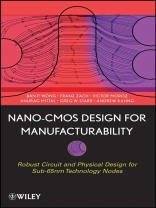Discover innovative tools that pave the way from circuit and
physical design to fabrication processing
Nano-CMOS Design for Manufacturability examines the challenges
that design engineers face in the nano-scaled era, such as
exacerbated effects and the proven design for manufacturability
(DFM) methodology in the midst of increasing variability and design
process interactions. In addition to discussing the difficulties
brought on by the continued dimensional scaling in conformance with
Moore’s law, the authors also tackle complex issues in the design
process to overcome the difficulties, including the use of a
functional first silicon to support a predictable product ramp.
Moreover, they introduce several emerging concepts, including
stress proximity effects, contour-based extraction, and design
process interactions.
This book is the sequel to Nano-CMOS Circuit and Physical
Design, taking design to technology nodes beyond 65nm geometries.
It is divided into three parts:
* Part One, Newly Exacerbated Effects, introduces the newly
exacerbated effects that require designers’ attention, beginning
with a discussion of the lithography aspects of DFM, followed by
the impact of layout on transistor performance
* Part Two, Design Solutions, examines how to mitigate the impact
of process effects, discussing the methodology needed to make
sub-wavelength patterning technology work in manufacturing, as well
as design solutions to deal with signal, power integrity, WELL,
stress proximity effects, and process variability
* Part Three, The Road to DFM, describes new tools needed to
support DFM efforts, including an auto-correction tool capable of
fixing the layout of cells with multiple optimization goals,
followed by a look ahead into the future of DFM
Throughout the book, real-world examples simplify complex
concepts, helping readers see how they can successfully handle
projects on Nano-CMOS nodes. It provides a bridge that allows
engineers to go from physical and circuit design to fabrication
processing and, in short, make designs that are not only
functional, but that also meet power and performance goals within
the design schedule.
Содержание
1. Introduction.
1.1 DFM — Value proposition.
1.2 Deficiencies in Boolean-based Design Rules in the
sub-wavelength regime [6].
1.3 Impact of Variability on Yield and Performance.
1.4 The industry challenge — disappearing process window.
1.5 Mobility enhancement techniques — a new source of
variability induced by design process interaction.
1.6 Design dependency of chip surface topology.
1.7 Newly exacerbated narrow width effect in nano-CMOS
nodes.
1.8 Well proximity effect.
1.9 Scaling beyond 65nm drives the need for model based DFM
solutions.
1.10 Summary.
PART 1: NEWLY EXACERBATED EFFECTS.
2. Lithography related Aspects of DFM.
2.1 Economic motivations for DFM.
2.2 Lithographic tools and techniques for advanced technology
nodes.
2.3 Lithography limited yield.
2.4 Lithography driven DFM Solutions.
3. Interaction of layout with transistor performance and
stress engineering techniques.
3.1 Introduction.
3.2 Impact of stress on transistor performance.
3.3 Stress propagation.
3.4 Stress sources.
3.5 Introducing stress into transistors.
PART 2: DESIGN SOLUTIONS.
4. Signal and Power Integrity.
4.1 Introduction.
4.2 Interconnect Resistance, Capacitance and Inductance.
4.3 Inductance Effects on Interconnect.
5. Analog and Mixed Signal Circuit Design for Yield and
Manufacturability.
5.1 Introduction.
5.2 Guidelines.
5.3 Device Selection.
5.4 Device Size Heart Beat.
5.5 Device Matching.
5.6 Design Guidelines.
5.7 Layout Guidelines.
5.8 Test.
6. Design for Variability, Performance and Yield.
6.1 Introduction.
6.2 Impact of variations (introduced by both process and circuit
operation) on the design.
6.3 Some Parametric Fluctuations with new implications for
design .
6.4 Process Variations in Interconnects.
6.5 Impact of Deep Sub-Micron Integration in SRAMs.
6.6 Impact of Layout Styles on Manufacturability, Yield and
Scalability.
6.7 Design for variations.
6.8 Summary.
PART 3: THE ROAD TO DFM.
7. Nano-CMOS design tools: Beyond model-based analysis and
correction.
7.1 Introduction.
7.2 Electrical Design for Manufacturability (DFM).
7.3 Criticality Aware DFM.
7.4 On Guardbands, Statistics, and Gaps.
7.5 Opportunistic Mindsets.
7.6 Futures at ó 45nm .
7.7 Summary.
7.8 References.
Об авторе
Ban P. Wong, CEng, MIET, is Director of Design Methodology at
Chartered Semiconductor, Inc. He holds five patents and is the lead
author of Nano-CMOS Circuit and Physical Design (Wiley).
Franz Zach, Ph D, is Senior Director at PDF Solutions, where he
is involved in integrated yield ramps at advanced technology
nodes.
Victor Moroz, Ph D, is a Principal Engineer at Synopsys. He
focuses on semiconductor physics, including silicon process
integration, teaching undergraduate and graduate students, and
developing process simulation and DFM tools.
Anurag Mittal, Ph D, Yale University, has co-developed the
world’s first truly CMOS-compatible Flash technology. He has
several papers, invited talks, and patents to his credit. Currently
he is Director of Technology & Applications at Takumi Inc.,
where he is developing novel EDA solutions on Design for
Variability & Reliability.
Greg W. Starr, Ph D, is a Supervising Principal Engineer at
Xilinx, where he is responsible for advanced serial IO development
on advanced processes.
Andrew Kahng, Ph D, is Professor of CSE and ECE at the University
of California, San Diego, and the CTO of Blaze DFM. His research
focuses on integrated circuit physical design and design for
manufacturability. Dr. Kahng has published more than 300 journal
and conference papers.












